Technology Deepdive
Two-stroke Opposed Piston Engines
Greenhouse gas standards in Europe will require 45% reduced CO2 emissions by the end of this decade, increasing to 90% reduction by 2040 (relative to a 2019 baseline). The U.S. EPA has recently proposed standards which will also require 25% reduction in CO2 emissions for long-haul trucks over 2029 – 2032. Meeting these reductions are not easy. Yes, electrification is seen as the weapon of choice but in the heavy-duty sector there are infrastructure challenges that must be overcome before the market takes off.
According to KGP, sales of medium- and heavy commercial vehicles are expected to double by 2040. As such, incremental improvements, while important, are unlikely to move the needle relative to the deep reductions in fuel consumption that are being sought by these standards. There are two approaches that look promising: one, a significant improvement in diesel engine and vehicle efficiency, and proliferation of non-conventional “engines” and fuels. The former includes, for example, the work done in the DOE funded SuperTruck program, which set the goal for improving diesel brake thermal efficiency to 55% and doubling the freight efficiency (all teams have met the goal in these last few months). The latter includes new engine architectures, combustion strategies, renewable and low carbon fuels, and electrification.
One promising technology that has gained significant traction is opposed-piston engines, championed by Achates Power for on-road applications. We take a deeper look at this exciting new technology.
The concept is not new, opposed piston engines have been around since the late 1800s. They were initially explored for cars – with one car introduced around 1900 – but they found more popularity in marine engines and submarines, especially in the World Wars. The engineering challenge then, was to perfect them for on-road heavy-duty applications, while meeting all the applicable emission standards.
Why Opposed Piston (OP) engines ?
Conventional engines have one piston in each cylinder. An OP engine on the other hand has two pistons working in opposite, reciprocating motion. The pistons come together in the middle of the cylinder for combustion – the piston crowns form most of the combustion chamber – and then separate. This eliminates the cylinder head, leading to several advantages:
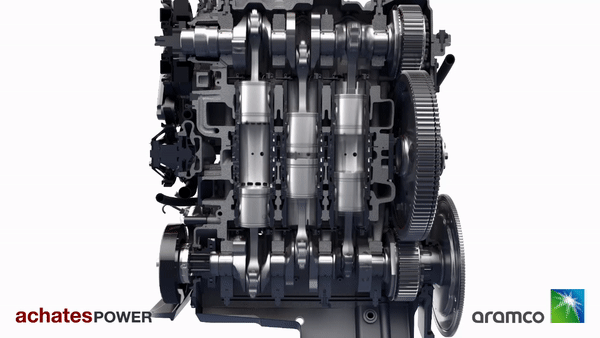
- Reduced weight
- A higher effective stroke-to-bore ratio and therefore increased engine efficiency.
- Reducing surface to volume ratio of the combustion chamber, leading to reduced heat transfer losses, and again increasing thermal efficiency.
- Lower soot emissions: the lack of cylinder head requires fuel injection orthogonal to the piston motion using two injectors. This leads to better fuel air mixing, lower fuel impingement on cylinder and piston surfaces, and lower soot emissions.
Furthermore, these are two-stroke engines, in which piston motion opens and closes the ports to enable gas exchange with efficient, uniflow scavenging. This eliminates the valvetrain – the OP engine does not have valves, valve springs, valve keepers, pushrods, rocker arms, camshafts, and other parts used to manage air intake in conventional engines. In principle, engine displacement can be halved compared to a comparable four-stroke engine but in practice OP engine displacement is generally only about 25% smaller than the comparable four-stroke (for example: a 5L three-cylinder two-stroke OP engine has the same power and torque as a 6.7L six-cylinder conventional four-stroke engine). The small heat release density enables faster and more efficient combustion at same maximum pressure rise rate.
Demonstration : the 10.7L, ~ 50% BTE engine
Achates Power has designed and built a new 10.6L OP engine aimed at the Class 8 market. Operating at a compression ratio of 17.6:1, the 3-cylinder engine delivers 300 kW at 1700 rpm and 2270 Nm of torque at 950 rpm.
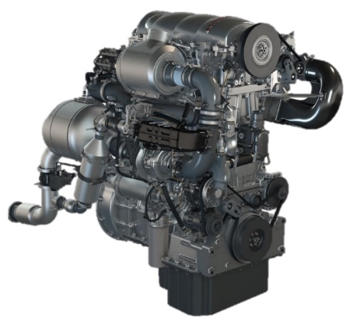
The measured peak brake thermal efficiency of the HD OP engine is near 50%. A plot of BTE shows that high efficiency is found across a wide range of operating conditions, enabling real world reductions in fuel consumption.
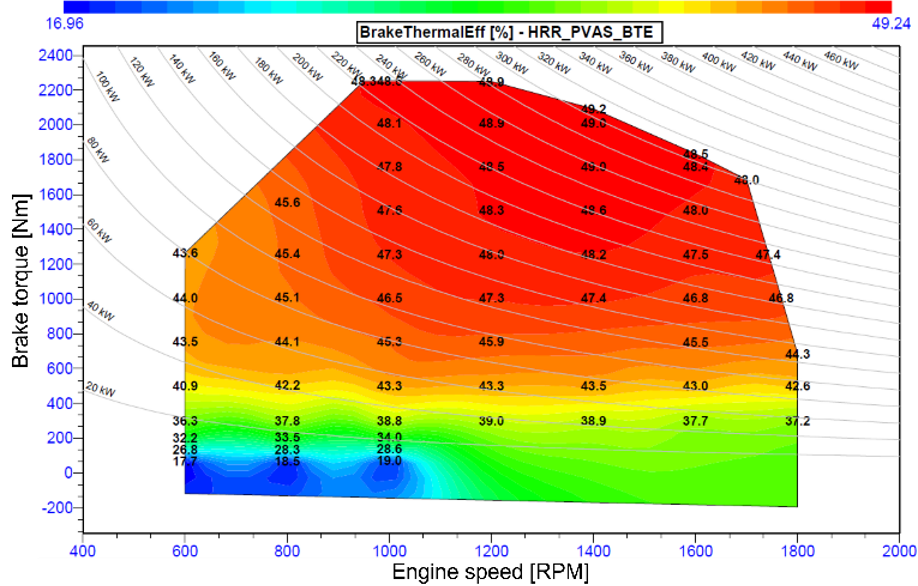
Achates Power 10.6L Opposed Piston Engine
(CAD rendering)
Engine map - brake thermal efficiency
What about criteria pollutant emissions?
If it were only meeting the CO2 targets, that would have been challenging and yet so much simpler. However, engines must also meet upcoming criteria pollutant standards – especially low NOx tailpipe limits – as have been proposed in Europe (“Euro 7”) and in the US. Diesel engines are expected to require major upgrades to both engine calibration and hardware, and the after-treatment systems to comply with these rules – and this is key – while also improving fuel economy. It can be done, as has been shown time and again by the industry. However, new concepts such as opposed piston engines offer another pathway to achieve these concurrent requirements with a minimal increase in the aftertreatment complexity.
Decoupled gas exchange and engine operation
The pistons in an OP engine are decoupled from inducting fresh air and exhausting combustion products. The scavenging of the cylinder is controlled by the air handling system such as with a supercharger and a variable geometry turbocharger. This “uniflow scavenging” allows for a tailoring of the cylinder composition for the desired engine operation. At low loads, for example, only a minimal amount of fresh air is required for the combustion cycle. Instead of scavenging almost the entire full cylinder and replacing it with cold, fresh air like a conventional four-stroke engine, the OP engine can retain some of the previous combustion residual instead of pushing it out, thereby reducing pumping work, but can also use that hot residual to maintain high exhaust temperatures for improved catalyst activity and the retained exhaust gas to inhibit NOX formation.
Example schematic of supercharger and turbocharger air path in an OP engine
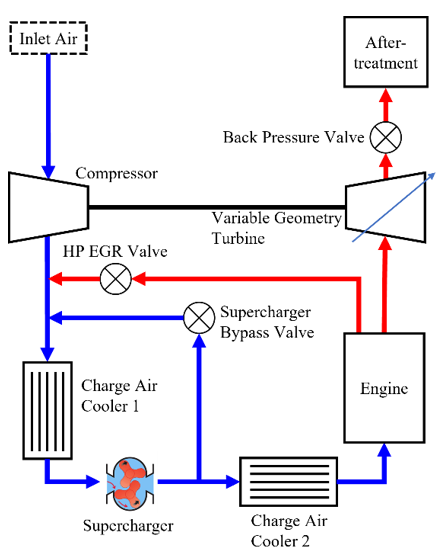
Early Catalyst Light-off
A key challenge in achieving low NOx emissions is the need to get the SCR catalyst temperature up to “light-off” temperature at which urea dosing can begin. This is being addressed using close-coupled SCR elements in conventional diesel, along with a dual dosing unit. This works but adds cost and complexity.
In an OP engine, decoupling of the gas exchange from engine operation enables a catalyst light-off mode that generates high exhaust enthalpy to quickly heat the SCR catalyst. The retained exhaust gases, combined with external EGR, create high levels of inert gases that results in low engine-out NOX emissions during catalyst light off. The combination of rapid catalyst light-off with low engine out NOx is the key for ultralow NOx emissions. This has been shown to reduce the time to light-off and the engine-out NOx emissions by half, compared to conventional engines.
Figures: Exhaust temperatures (left) and engine out NOx in catalyst heating mode (right).
The “SwRI” datasets refer to a baseline MY2017 conventional engine tested at Southwest Research Institute before and after engine calibration and design modifications for ultralow NOX.

Low NOx emissions can be met - with conventional after-treatment
The engine was paired with a conventional after-treatment system, i.e. one without a close-coupled SCR, which otherwise seems a certain addition to diesels to meet the MY 2027+ low NOx regulations. As shown below, this consisted of a diesel oxidation catalyst (DOC), SCR on filter, and another SCR and ammonia slip catalyst (ASC).
The engine was integrated into a Peterbilt 579 truck and driven in fleet service by a major retailer. As part of the project, in-use NOx testing was done by the University of California Riverside College of Engineering – Center for Environmental Research and Technology using an updated Portable Emissions System (PEMS).
Table below summarizes over three days of in-use testing. Very low levels of tailpipe NOx were measured at all three bins (Bin 1 is idle; Bin 2 is low load; Bin 3 is medium/high load).
It is seen that the stringent California requirements are met with a comfortable margin.
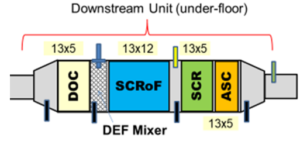

Further improvements
To further simplify the aftertreatment system and enable passive DPF regeneration, a new aftertreatment configuration based on a MY2021 single box system was considered, as shown in the figure.
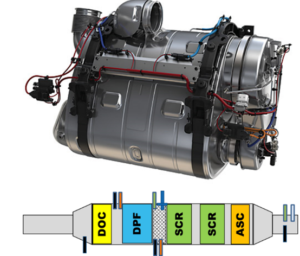
The air system was also updated with a SuperTurbo driven turbocharger coupled with an electric EGR pump. The driven turbocharger consumes power, either electrical or mechanical in this case, to spin the compressor and provide a positive pressure ratio across the engine, eliminating the need for a supercharger. This updated air path configuration provides increased durability and higher efficiency.
Simulations done with a MY 2021 after-treatment system and with the above improvements predict that the OP engine could achieve NOx as low as 0.007 g/bhp-hr, 65% below the low NOx limit of 0.02 g/bhp-hr. Furthermore, CO2 emissions are expected to be 8% below the 2027 target.
More to come
There are no silver bullets in the quest for decarbonization of transport. Every solution counts and will be needed to address this complex task. Opposed piston engines offer a promising tool, and we have barely touched the surface here.
As can be understood, the engine can be paired with a hybrid powertrain and with low carbon fuels for further well-to-wheel CO2 reduction. These avenues are being explored, and progress was reported at the recent 2023 Vehicle Technologies Office Annual Merit Review. Download presentations here, specifically look for the talks under the “Decarbonization” program”.
Sign up here to receive such summaries and a monthly newsletter highlighting the latest developments in transport decarbonization
5-Min Monthly
Sign-up to receive newsletter via email
Thank you!
You have successfully joined our subscriber list.
Recent Posts
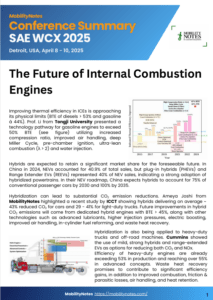
Conference Summary – SAE WCX 2025
![]()
A summary of the “SAE WCX 2025” conference held in Detroit.
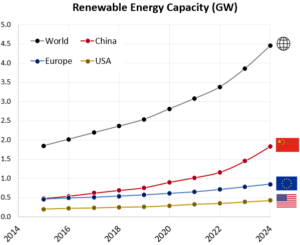
IRENA Renewable Energy Capacity Statistics 2025
![]()
According to the latest report from IRENA, 2024 saw the largest increase in renewable capacity, accounting for 92.5% of overall power additions.
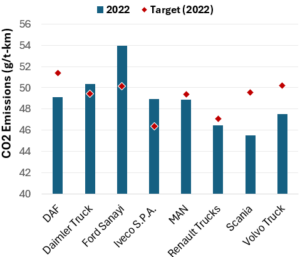
CO2 Emissions Performance of Heavy-Duty Vehicles in Europe – 2022 Results
![]()
The European Commission has published the official 2022 CO2 emission results for heavy-duty vehicles. Many OEMs are ahead of the targets and have gained credits, while others have their work cut out as we approach the 2025 target.

